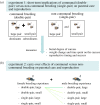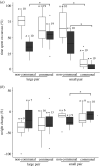Sex-specific influence of communal breeding experience on parenting performance and fitness in a burying beetle
- PMID: 35223054
- PMCID: PMC8847889
- DOI: 10.1098/rsos.211179
Sex-specific influence of communal breeding experience on parenting performance and fitness in a burying beetle
Abstract
Communal breeding, wherein multiple conspecifics live and reproduce together, may generate short-term benefits in terms of defence and reproduction. However, its carry-over effects remain unclear. We experimentally tested the effects of communal breeding on parental care and reproduction in burying beetles (Nicrophorus vespilloides), which use carcasses as breeding resources and provide parental care to offspring. We subjected individuals to communal or non-communal breeding (i.e. pair breeding) during their first breeding event and to non-communal breeding during their second breeding event. We measured the parental care of individuals and of groups and the reproductive success of groups during both breeding events. In communal groups, large individuals became dominant and largely monopolized the carcass, whereas small individuals (i.e. subordinates) had restricted access to the carcass. At the first breeding event, large males in communal groups spent more time providing care than large males in non-communal groups, whereas such an effect was not observed for large females and small individuals. Reproductive successes were similar in communal and non-communal groups, indicating no short-term benefits of communal breeding in terms of reproduction. Compared with males from non-communal groups, males originating from communal groups produced a larger size of brood during their second breeding event, whereas such an effect was not observed for females. Our results demonstrate the sex-specific effects of communal breeding experience on parenting performance and fitness.
Keywords: burying beetle; carry-over effects; communal breeding; parental investment; previous breeding experience; sexual conflict.
© 2022 The Authors.
Figures





Similar articles
-
Revisiting the ecology and evolution of burying beetle behavior (Staphylinidae: Silphinae).Ecol Evol. 2024 Aug 20;14(8):e70175. doi: 10.1002/ece3.70175. eCollection 2024 Aug. Ecol Evol. 2024. PMID: 39170054 Free PMC article. Review.
-
Carcass size, not source or taxon, dictates breeding performance and carcass use in a burying beetle.R Soc Open Sci. 2024 Oct 30;11(10):241265. doi: 10.1098/rsos.241265. eCollection 2024 Oct. R Soc Open Sci. 2024. PMID: 39479237 Free PMC article.
-
Access to resources buffers against effects of current reproduction on future ability to provide care in a burying beetle.Ecol Evol. 2022 Sep 9;12(9):e9266. doi: 10.1002/ece3.9266. eCollection 2022 Sep. Ecol Evol. 2022. PMID: 36177135 Free PMC article.
-
Sexual division of antibacterial resource defence in breeding burying beetles, Nicrophorus vespilloides.J Anim Ecol. 2010 Jan;79(1):35-43. doi: 10.1111/j.1365-2656.2009.01593.x. Epub 2009 Jul 16. J Anim Ecol. 2010. PMID: 19627394
-
Burying beetles as a model organism to study sex differences in parental care.Insectes Soc. 2025;72(2):193-204. doi: 10.1007/s00040-024-01010-0. Epub 2024 Dec 1. Insectes Soc. 2025. PMID: 40519858 Free PMC article. Review.
Cited by
-
Revisiting the ecology and evolution of burying beetle behavior (Staphylinidae: Silphinae).Ecol Evol. 2024 Aug 20;14(8):e70175. doi: 10.1002/ece3.70175. eCollection 2024 Aug. Ecol Evol. 2024. PMID: 39170054 Free PMC article. Review.
-
Heat stress effects on offspring compound across parental care.Proc Biol Sci. 2025 Mar;292(2042):20250026. doi: 10.1098/rspb.2025.0026. Epub 2025 Mar 5. Proc Biol Sci. 2025. PMID: 40041959 Free PMC article.
-
Temperature Variation Regulates the Trade-Off Between Pre- and Post-Hatching Investment in a Burying Beetle.Insects. 2025 Apr 2;16(4):378. doi: 10.3390/insects16040378. Insects. 2025. PMID: 40332889 Free PMC article.
References
-
- Taborsky M, Cant M, Komdeur J. 2021. The evolution of social behaviour. Cambridge, UK: Cambridge University Press.
-
- Komdeur J, Richardson DS, Hammers M, Eikenaar C, Brouwer L, Kingma SA. 2017. The evolution of cooperative breeding in vertebrates. eLS, 1-11. (10.1002/9780470015902.a0021218.pub2 - DOI
Associated data
LinkOut - more resources
Full Text Sources
Other Literature Sources

